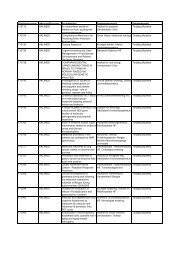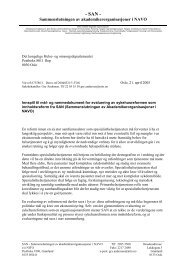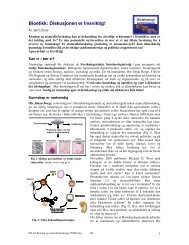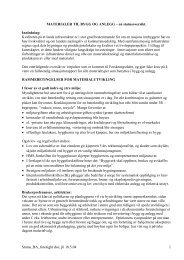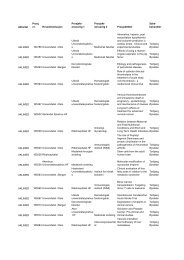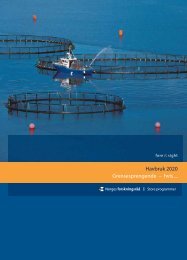A Revolution in R&D
A Revolution in R&D
A Revolution in R&D
Create successful ePaper yourself
Turn your PDF publications into a flip-book with our unique Google optimized e-Paper software.
12<br />
The Opportunities<br />
What is the impact of genomics on the economics<br />
of R&D? To what extent will genomics improve productivity<br />
overall, and what will its effects be when<br />
applied at various po<strong>in</strong>ts of the value cha<strong>in</strong>? What<br />
other <strong>in</strong>cidental advantages might genomics br<strong>in</strong>g<br />
<strong>in</strong> its wake?<br />
These crucial questions have received a great deal<br />
of attention of late, and a wide variety of responses.<br />
To address the questions <strong>in</strong> a rigorous, fact-based<br />
way, we built an economic model of the entire R&D<br />
value cha<strong>in</strong>, grounded <strong>in</strong> a program of discussions<br />
with<strong>in</strong> the <strong>in</strong>dustry (more than 100 meet<strong>in</strong>gs with<br />
more than 60 scientists and executives from nearly<br />
50 companies and academic <strong>in</strong>stitutions.) (See the<br />
methodology section at the end of this report.)<br />
Realiz<strong>in</strong>g Sav<strong>in</strong>gs<br />
Before genomics technology, develop<strong>in</strong>g a new<br />
drug has cost companies on average $880 million,<br />
and has taken about 15 years from start to f<strong>in</strong>ish,<br />
that is, from target identification 2 through regulatory<br />
approval. (See Exhibit 2.) Of this cost, about 75<br />
percent can be attributed to failures along the way.<br />
By apply<strong>in</strong>g genomics technology, companies could<br />
on average realize sav<strong>in</strong>gs of nearly $300 million<br />
and two years per drug, largely as a result of efficiency<br />
ga<strong>in</strong>s. That represents a 35 percent cost and<br />
15 percent time sav<strong>in</strong>gs. (And those are the sav<strong>in</strong>gs<br />
possible with technologies that are available today;<br />
when new or improved genomics technologies<br />
emerge, the sav<strong>in</strong>gs will be even greater.) If companies<br />
wish to stay competitive, they have no choice:<br />
they must implement genomics technologies. (See<br />
Exhibit 3.)<br />
Do<strong>in</strong>g so, however, will hardly produce such huge<br />
sav<strong>in</strong>gs immediately, or automatically. It will take a<br />
few years, and many deft decisions, for the sav<strong>in</strong>gs<br />
to be realized. The early years of implementation<br />
may <strong>in</strong> fact <strong>in</strong>volve an <strong>in</strong>crease <strong>in</strong> costs as the learn<strong>in</strong>g<br />
curve is negotiated for novel targets—specifi-<br />
EXHIBIT 2<br />
DRUG R&D IS EXPENSIVE AND TIME-CONSUMING<br />
Cost: $880 million total<br />
Approximate cost ($M)<br />
165<br />
205<br />
Time: 14.7 years total<br />
Approximate time (yrs)<br />
1<br />
Biology<br />
2<br />
Target ID Target Validation<br />
40<br />
0.4<br />
Chemistry<br />
cally, as the necessary quality controls are established—and<br />
as major strategic decisions (about<br />
personnel and processes, for <strong>in</strong>stance) are confirmed<br />
or revised.<br />
More on these challenges later. But first, we will<br />
take a closer look at the long-term upside, detail<strong>in</strong>g<br />
the sav<strong>in</strong>gs at various steps along the value cha<strong>in</strong>.<br />
120<br />
2.7<br />
Screen<strong>in</strong>g Optimization<br />
90<br />
1.6<br />
Development<br />
260<br />
7<br />
Precl<strong>in</strong>ical Cl<strong>in</strong>ical<br />
SOURCES: BCG analysis; <strong>in</strong>dustry <strong>in</strong>terviews; scientific literature; public<br />
f<strong>in</strong>ancial data; Lehman Brothers; PAREXEL’S Pharmaceutical R&D<br />
Statistical Sourcebook 2000.<br />
NOTE: Cost to drug <strong>in</strong>cludes failures. Target identification <strong>in</strong>cludes <strong>in</strong>itial<br />
experiments that companies may have outsourced to academic research<br />
<strong>in</strong>stitutions.<br />
2. Includes <strong>in</strong>itial experiments to identify potential targets. Traditionally, companies have sourced much of this research from academia.



